When most people think about bionic hands, they imagine movement—the ability to open, close, and grip. But real control is not only about movement. It is about feeling.
Touch tells us when we are holding something too tightly. It lets us sense when something is slipping. It reassures us that an object is secure without needing to look.
For someone with a prosthetic, this feeling has long been missing. The hand could move, but it could not “talk back” to the brain. That gap made control harder, slower, and less natural.
Haptic feedback changes this. By sending signals back to the user—through vibration, pressure, or subtle stimulation—it closes the loop between brain and prosthetic. It doesn’t just make movement possible. It makes learning faster. It makes control precise. It makes the prosthetic feel like part of the body.
At Robobionics, we have seen how haptic feedback accelerates brain adaptation. It doesn’t just restore function. It rebuilds confidence, identity, and independence.
In this article, we’ll explore why haptic feedback matters, how it works, and how it transforms the journey of brain adaptation in prosthetic use.
What is Haptic Feedback in Bionics?
The Language of Touch
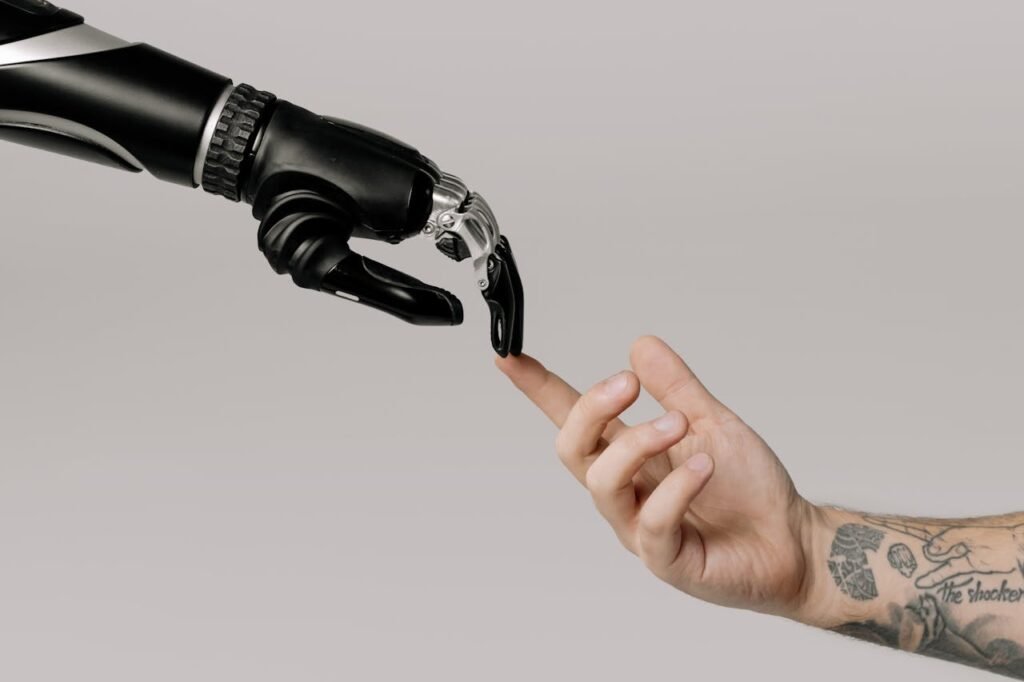
Haptic feedback is the use of signals like vibration, pressure, or gentle stimulation to mimic the sense of touch. In prosthetics, it works by giving users information about what their artificial limb is doing.
When a bionic hand grips an object, sensors measure the force or detect slipping. That information is then translated into a signal sent to the user’s residual limb. The brain interprets this as touch.
It may not feel exactly like natural skin contact, but it delivers meaningful awareness. The user knows, without looking, whether their grip is firm, light, or slipping.
Closing the Loop
Without feedback, prosthetics operate in what’s called an open-loop system. The brain sends commands, the hand moves, but no information comes back. This forces the user to rely on sight, which is tiring and imprecise.
Haptic feedback closes the loop. Now, the brain gets information back. It can adjust commands in real time, just as it would with a natural hand.
This loop transforms control. It doesn’t just make actions possible—it makes them natural.
Why This Matters for Brain Adaptation
The brain thrives on feedback. It expects to know the result of every action. When you reach for a glass, your brain predicts how it should feel. If the feedback matches, learning is reinforced. If not, the brain adjusts.
With haptic feedback, prosthetic users regain this vital loop. Every movement becomes a lesson. The brain quickly adapts, strengthening its connection to the prosthetic.
This is why feedback is not a luxury—it is a necessity for faster and deeper brain adaptation.
How Haptic Feedback Accelerates Learning
Faster Skill Acquisition
For a new user, learning to control a bionic hand can be overwhelming. Signals are unfamiliar, movements feel clumsy, and mistakes are frequent.
Haptic feedback shortens this learning curve. Each mistake provides immediate information. If the grip is too tight, the signal tells the brain to ease off. If the object slips, the brain learns to tighten the hold.
This instant correction speeds up skill acquisition. What might take months of visual trial-and-error can often be learned in weeks.
Reinforcing Neural Pathways
Every time the brain sends a signal and receives useful feedback, the connection strengthens. This is how neural pathways grow.
Think of it like carving a path through a forest. With feedback, each step clears the trail faster. Soon, the path becomes a highway. The signal flows smoothly, and movement feels natural.
This reinforcement is at the heart of neuroplasticity. Feedback doesn’t just make control easier—it literally shapes the brain to accept the prosthetic as part of the body.
Reducing Mental Fatigue
Controlling a prosthetic without feedback is exhausting. Users must watch every movement, calculate grip visually, and correct errors manually.
Haptic feedback reduces this mental load. The brain no longer needs to overthink. It gets information automatically, freeing mental energy for other tasks.
This makes prosthetic use sustainable. Instead of tiring after a few hours, users can wear and rely on their device all day.
Different Types of Haptic Feedback
Vibrotactile Feedback
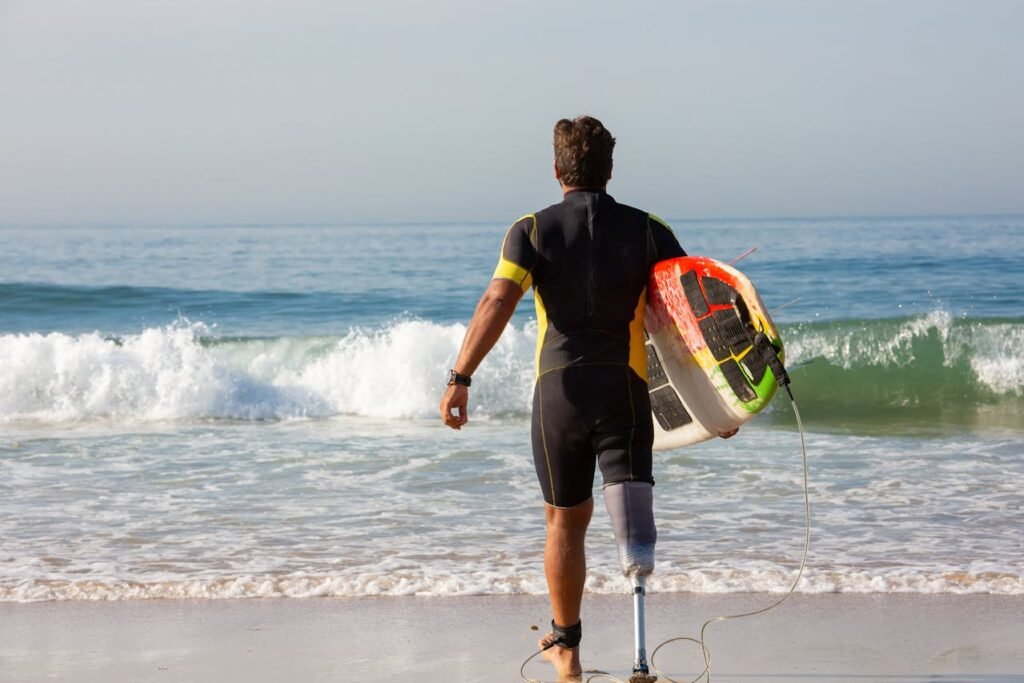
One of the most common methods is vibration. Small motors create pulses on the skin, with variations in frequency or intensity signaling different grip strengths or conditions.
It’s simple, affordable, and easy for the brain to interpret. Even basic vibration cues can dramatically improve control and learning speed.
Pressure-Based Feedback
Some systems apply pressure to the residual limb, mimicking the sensation of touch or force. For example, as grip force increases, a small pad presses more firmly against the skin.
This method provides a more natural, graded sense of force, helping the brain judge subtle differences in pressure.
Electrical Stimulation
More advanced systems use tiny electrical signals to stimulate nerves directly. This creates a sensation closer to real touch.
Though still in early stages, this approach holds promise for more immersive, natural experiences of feedback—like feeling texture or even temperature.
Real-World Applications of Haptic Feedback
Everyday Tasks Made Easier
For many prosthetic users, daily tasks like pouring water, tying shoelaces, or holding a fragile cup can feel risky. Without feedback, they must rely on sight alone, often gripping too hard or too soft.
With haptic feedback, these tasks become smoother. A vibration can signal when the grip is firm enough, while a change in pulse warns if an object is slipping. Users no longer need to watch every move—they simply act.
This ease transforms daily living. What once felt like a chore becomes natural again.
At Work and in Professional Roles
Precision matters in the workplace. Imagine a craftsman handling tools, a surgeon training in simulation, or a teacher writing on the board. Each requires subtle, reliable movements.
Haptic feedback supports these roles by giving the brain real-time information. It ensures grip consistency, reduces errors, and builds confidence.
This makes it possible for users to not just return to work, but to excel in their chosen fields.
In Social and Emotional Interactions
Touch is also about connection. A handshake, a hug, or holding a child’s hand carries meaning beyond function. Without feedback, these interactions can feel awkward or forced.
With haptic systems, users regain control over these small but powerful gestures. They can hold hands without fear of squeezing too hard. They can hug with comfort. They can rejoin moments that make relationships whole.
User Journeys: Stories of Transformation
From Frustration to Flow
One of our users, a university student, shared how his first experience with a prosthetic hand felt frustrating. He had to watch every movement and often dropped objects during class.
When he upgraded to a feedback-enabled prosthetic, the change was remarkable. Within weeks, he was typing faster, handling books easily, and even participating in lab experiments without worry.
He said the biggest shift wasn’t just physical—it was emotional. He felt like his hand was truly his again.
Precision for a Working Professional
Another user, a software developer, needed to work long hours at his computer. His earlier device left him mentally drained because of the constant effort required to manage keystrokes.
With haptic feedback, his brain relaxed. The cues guided him without constant visual checking. He described the experience as “like switching from learning to drive a car to just driving it.”
This story highlights how feedback doesn’t just restore function—it restores flow.
Returning to Family Life
A mother who lost her hand due to illness told us her biggest fear wasn’t about work—it was about family. She worried about cooking safely, holding her child, or managing small chores.
With a prosthetic equipped with haptic feedback, she found reassurance. She could measure her grip while cutting vegetables. She could hold her child without fear. She could feel like herself again in her own home.
Her words remind us that adaptation is not only about performance—it’s about belonging.
Business Strategies for Clinics and Providers
Offering Feedback as a Differentiator
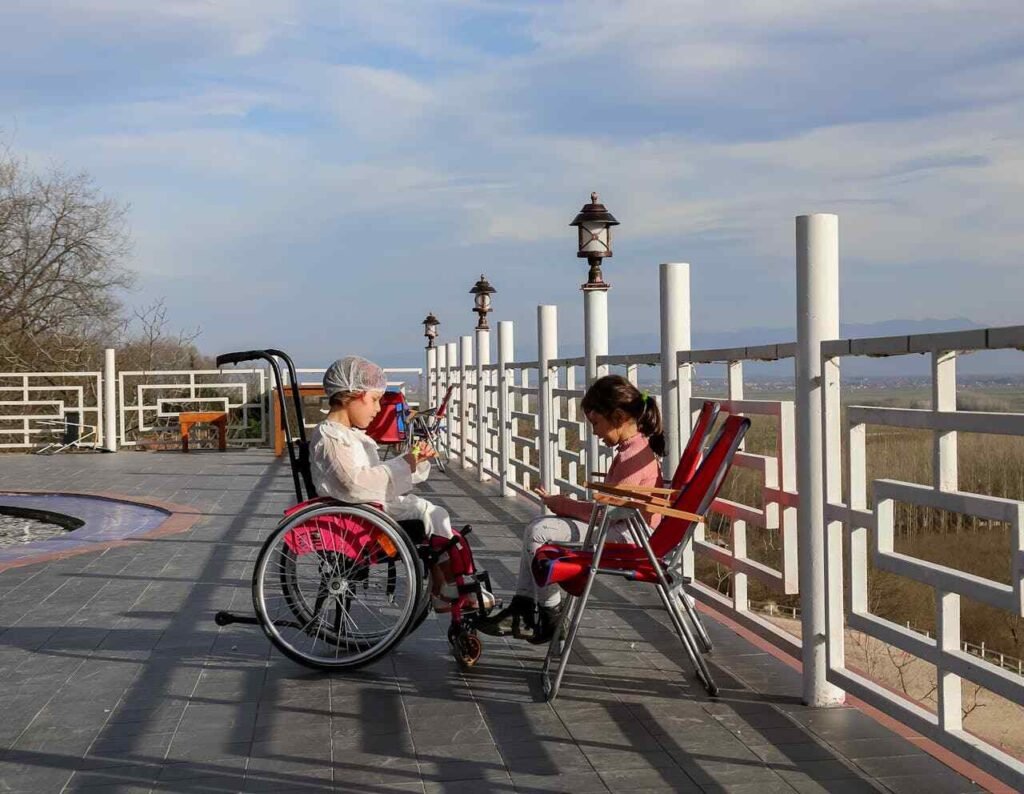
In India, most prosthetic clinics still focus on movement alone. Very few emphasize feedback. This gap is an opportunity.
Clinics that introduce feedback-enabled prosthetics can stand apart. They can market not just motion, but mastery. Not just devices, but dignity.
For patients, that message is powerful. It shifts the conversation from “Can I move?” to “Can I live fully again?”
Training as a Value-Added Service
Feedback requires guidance. Users need to learn what different signals mean and how to respond. Clinics can make this training part of their value proposition.
By offering structured training programs, workshops, and follow-ups, providers build deeper relationships with patients. They don’t just sell a prosthetic—they provide a journey.
This builds loyalty, reduces abandonment, and creates referrals.
Making It Accessible
Advanced systems are often seen as too costly for most families. But local manufacturing, modular designs, and financing options can change this.
By offering tiered packages—basic models, mid-range feedback-enabled models, and premium systems—clinics can make sure that feedback technology reaches more users.
Accessibility doesn’t just expand markets. It fulfills the true mission of prosthetics: restoring independence for as many people as possible.
Rehabilitation Strategies with Haptic Feedback
Why Rehab Feels Different with Feedback
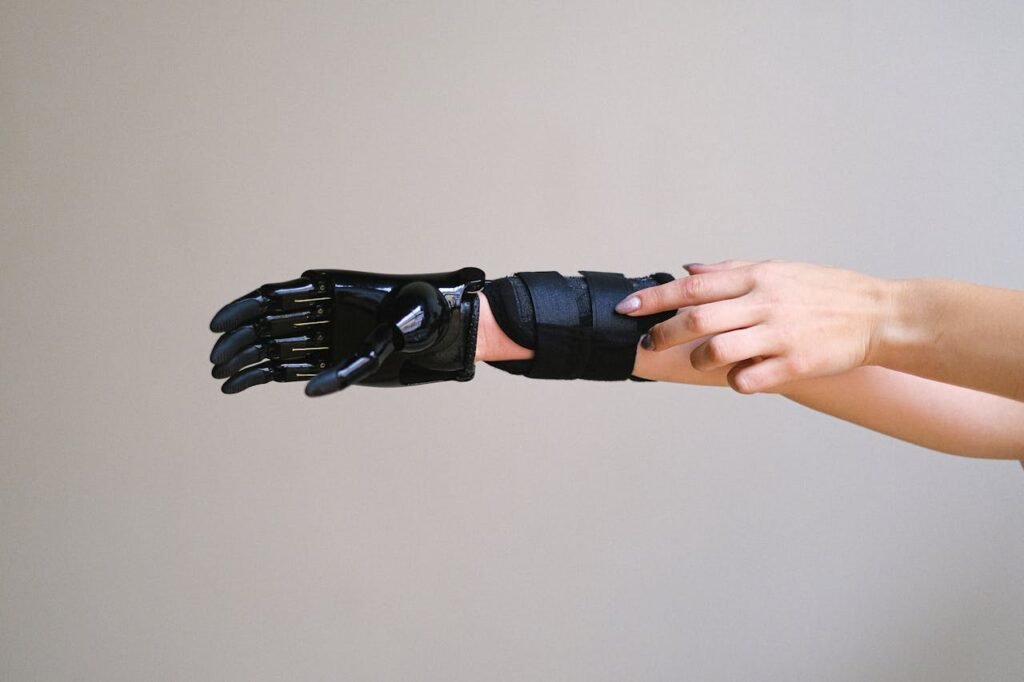
Rehabilitation after limb loss is about more than building strength. It’s about teaching the brain and body to work with a new system. Without feedback, rehab can feel slow and frustrating—users must rely on sight and guesswork.
With haptic feedback, every exercise provides immediate information. The brain gets a clear signal about grip strength, force, or slippage. This speeds up learning. It also makes practice feel rewarding because progress is easier to sense.+
Early Training for Faster Adaptation
The first weeks of rehab are critical. During this stage, the brain is highly receptive to new inputs. When haptic feedback is introduced early, adaptation happens faster.
Therapists can design exercises that build trust in the prosthetic. For example, practicing picking up light and fragile objects with vibration cues helps the brain fine-tune motor signals. Each session reinforces neural pathways, making movements smoother.
Gamifying Rehabilitation
Repetitive tasks can feel boring. Gamified rehab—using apps or digital challenges—makes training fun and engaging.
When paired with haptic feedback, these games become even more powerful. For instance, a game may ask the user to grip virtual objects with varying force. The prosthetic provides haptic cues, while the game tracks accuracy.
This makes practice enjoyable and motivating, ensuring users stay committed to their rehabilitation journey.
The Role of Therapists in Feedback Training
Therapists play a key role in helping users interpret and trust haptic signals. At first, vibrations or pressure may feel strange. With guidance, users learn what each signal means and how to respond.
Clinics that train therapists specifically in feedback-based rehab will see higher success rates. Therapists act as translators between brain and machine, guiding users toward confidence and mastery.
Emotional Well-Being and Haptic Feedback
Rebuilding Trust in the Body
Losing a limb can make people feel disconnected from their own bodies. A prosthetic without feedback often feels foreign—a tool, not a part of the self.
Haptic feedback rebuilds this trust. It reassures users that their actions are controlled and reliable. Over time, the prosthetic feels less like something external and more like part of their body map.
This restoration of trust is often the first step toward emotional healing.
Reducing Fear and Anxiety
Many users live with constant worry—will I drop this object? Will I squeeze too hard? Will I embarrass myself in public?
Haptic feedback reduces these fears. The signals act as a safety net, warning users before mistakes happen. With fewer errors, confidence grows.
Less anxiety means users engage more—socially, professionally, and personally. They stop holding back. They start living fully again.
Belonging and Identity
For some, the most profound shift is not physical but emotional. When a prosthetic responds with precision, supported by feedback, it becomes part of identity.
Users no longer see themselves as incomplete. They feel whole again. They hug, shake hands, or hold objects without hesitation. These moments may look small, but they carry immense emotional weight.
It’s this sense of belonging that transforms prosthetic use from occasional to everyday.
Scaling Haptic Feedback for Wider Impact
Bridging the Accessibility Gap
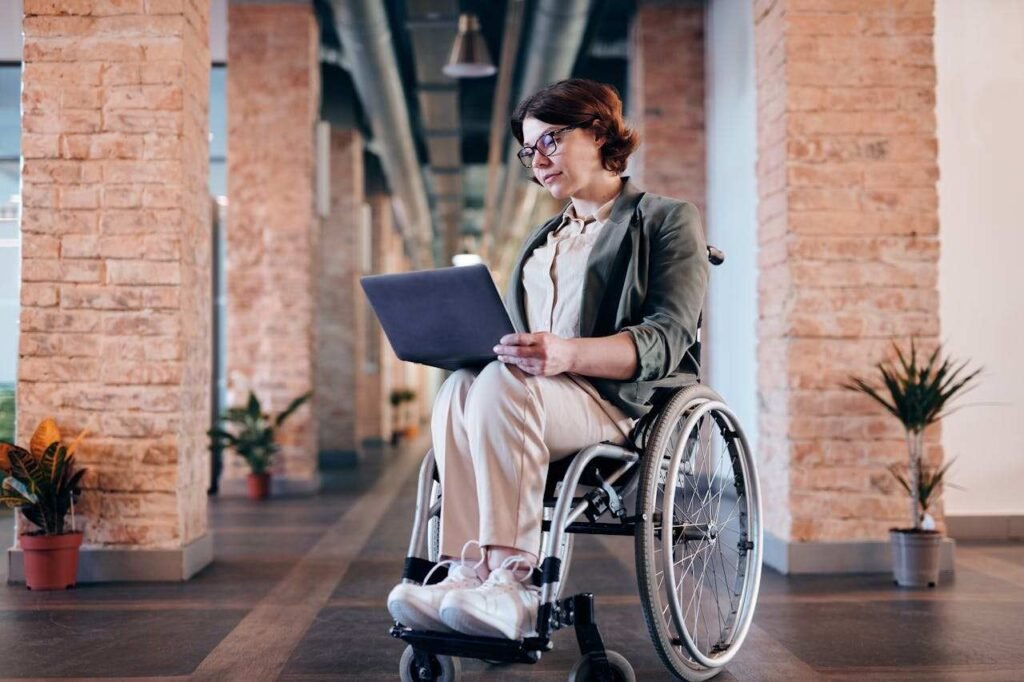
Globally, advanced prosthetics are often expensive and out of reach. Imported models with feedback systems can cost many lakhs, making them unaffordable for most families in India.
At Robobionics, we are solving this through local manufacturing. By designing and producing most components in India, we reduce costs while maintaining quality.
This approach makes haptic feedback available to more users—not just the wealthy few.
Building Partnerships with Clinics
Scaling feedback technology requires collaboration with clinics and hospitals. By offering training, demo units, and shared learning programs, we make adoption smoother for providers.
When clinics see that feedback reduces abandonment and increases satisfaction, they naturally recommend these systems more often.
Creating Tiered Options
Not every user needs the same level of feedback. Some may benefit from simple vibration cues, while others need advanced, multi-channel signals.
By offering tiered options—basic, intermediate, and advanced—businesses can reach more people. This ensures that even budget-conscious users can experience the benefits of feedback.
Financing and Support Programs
Affordability is not just about cost—it’s also about payment flexibility. Many families cannot pay a large amount upfront, but they can manage smaller installments.
By partnering with NGOs, insurance providers, or micro-financing groups, businesses can spread payments and make advanced prosthetics more accessible.
Awareness and Education
Many people don’t yet know what haptic feedback is or why it matters. Education is key to adoption.
By hosting workshops, sharing success stories, and demonstrating the difference feedback makes, businesses can build awareness. When users understand the value, they actively seek it.
The Future of Haptic Technology in Prosthetics
From Simple Signals to Rich Sensations
Today, most feedback systems use simple signals like vibration or pressure. They’re effective, but they only scratch the surface of what’s possible.
The future lies in richer sensations—where users can feel texture, weight, or even temperature. Imagine running your fingers across cloth and sensing its softness, or picking up a cup and feeling whether it’s hot or cold.
These advancements will make prosthetics feel even closer to natural limbs.
Personalized Feedback Through AI
Not every brain responds the same way. Some users adapt quickly to vibration, while others find pressure more intuitive.
Artificial intelligence will help personalize feedback. By studying how each user responds, AI can adjust signal strength, timing, and style. Over time, the prosthetic won’t just provide feedback—it will provide feedback designed specifically for the user’s brain.
This personalization will accelerate adaptation even further.
Integration With Other Technologies
Future prosthetics won’t exist in isolation. They’ll integrate with other tools—rehabilitation apps, wearable sensors, even smart home systems.
For example, a prosthetic could connect to a rehab app that tracks daily grip strength and suggests exercises. Or it could sync with smart devices, allowing seamless interaction with phones, computers, and appliances.
The prosthetic will no longer be just a limb replacement. It will be a gateway to a connected lifestyle.
Expanding to Lower Limbs and Beyond
Most haptic research today focuses on hands and arms. But feedback is just as valuable in lower-limb prosthetics.
Imagine a prosthetic leg that provides cues about ground texture, slope, or stability. This would give users more confidence when walking on uneven surfaces, reducing falls and improving mobility.
Beyond limbs, haptic technology could also support rehabilitation after strokes or spinal injuries—any situation where the brain needs to relearn control.
Business Growth Strategies for Providers
Differentiation Through Innovation
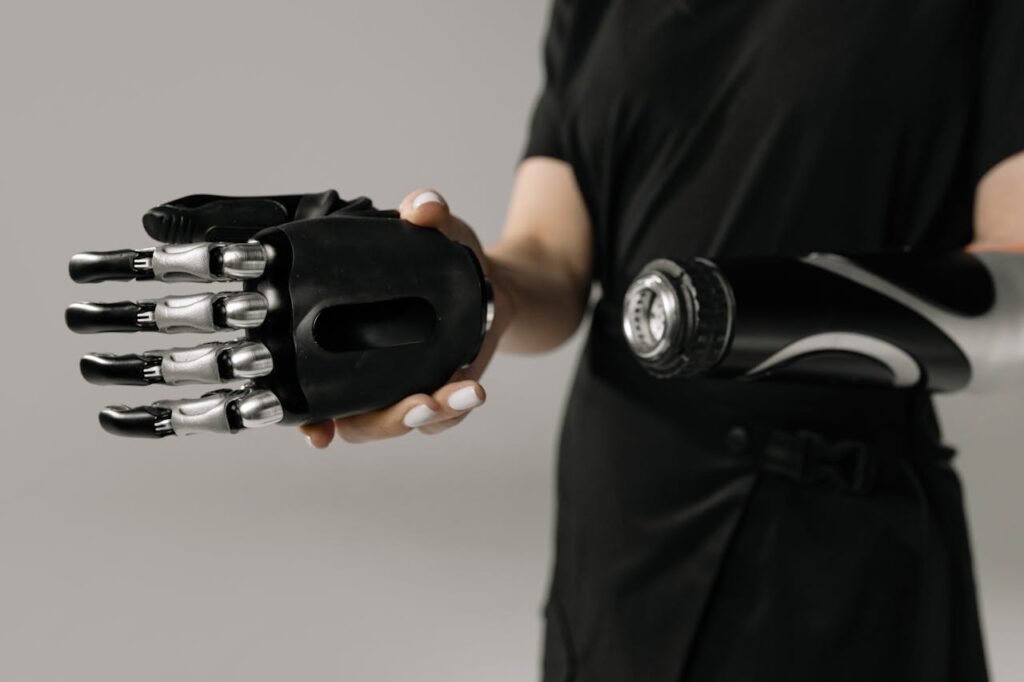
In a market where many providers still focus on movement alone, offering haptic-enabled prosthetics is a clear differentiator.
Clinics that emphasize feedback position themselves as leaders in innovation. They attract patients who want not just motion, but mastery. They build a reputation for delivering cutting-edge care.
This is not just a technical edge—it’s a business edge.
Building Long-Term Relationships
Prosthetics are not a one-time sale. They require ongoing support, training, and upgrades. Businesses that invest in long-term relationships—through training programs, follow-ups, and feedback tracking—gain loyalty.
When users feel supported, they are more likely to stay connected, return for upgrades, and refer others.
Offering Flexible Options
Accessibility expands markets. By offering tiered models—basic, intermediate, and advanced—providers can reach a wider audience.
Pairing this with financing options or partnerships with NGOs ensures that more people can access advanced systems without financial strain.
Leveraging Storytelling
In healthcare, the most powerful marketing isn’t technical specs—it’s human stories.
A farmer holding tools again. A student writing in class without hesitation. A mother hugging her child with confidence.
These stories carry emotional weight. They show not just what the technology does, but what it means. Sharing them builds trust and inspires hope.
Conclusion: Touch as the Bridge to Belonging
Haptic feedback is more than technology. It is the missing link between prosthetics and the brain. It turns motion into control, effort into ease, and uncertainty into trust.
For users, feedback accelerates adaptation. It makes the prosthetic feel like part of the body, not just something worn. It restores confidence, dignity, and identity.
For businesses and clinics, feedback is the path to differentiation, loyalty, and growth. It transforms outcomes, strengthens reputations, and opens doors to new partnerships.
And for society, it marks a turning point. Prosthetics are no longer just about restoring movement. They are about restoring life.
At Robobionics, we are committed to making this future accessible. Through local innovation, affordability, and a deep focus on users, we are bringing world-class haptic feedback technology to India.
If you or someone you know is ready to experience this transformation, book a free demo today:
Because when you can feel again, you don’t just adapt—you belong.



